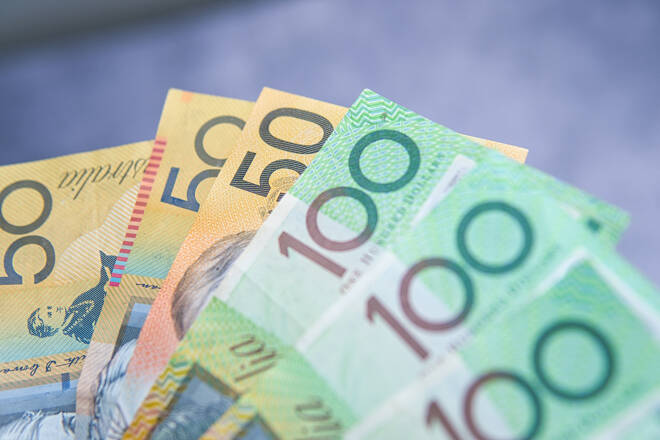Advertisement
Advertisement
AUDUSD Forecast 2023 – Performance Hinges Upon Fed Rate Hike Pace, Lifting of China COVID Restrictions
By:
The Australian Dollar struggled in 2022 due to the Federal Reserve's rate hikes, China's COVID lockdowns, and lower commodity prices and global equity markets. In 2023, these factors will continue to impact the currency.
The Australian Dollar started 2022 on an upswing against the U.S. Dollar but topped out in April shortly after the U.S. Federal Reserve’s first interest rate hike of the year. That simple move set in motion a bearish year for the Aussie that eventually drove the currency down 15% before a late year retracement clawed back some of those losses. Nonetheless, the AUDUSD is in a position to finish about 7% lower for the year.
Although the Federal Reserve’s aggressive rate hike cycle contributed the most to the AUD/USD’s loss, some of the blame for the weakness has to be shared with China’s prolonged COVID lockdowns that weighed on domestic growth.
Reserve Bank of Australia Recap
The Reserve Bank of Australia (RBA) hiked interest rates eight times in 2022. These moves brought the benchmark interest rate to 3.1% as of the end of the year, driving borrowing costs to the highest level in a decade and marking the fastest RBA’s tightening cycle since 1989.
The RBA rate hike cycle may have kept the Australian Dollar from falling against other major currencies like the Japanese Yen, Euro and British Pound, but it couldn’t keep pace with the supersized rate hikes from the Federal Reserve, contributing to a massive sell-off throughout the summer and some of the fall until the Fed started hinting at a possible slowdown in its tightening cycle.
The Australian Dollar’s 2022 Technical Review
The AUDUSD finished 2021 at .7268. After trading sideways-to-lower for the first two months of the year, the Forex pair surged to its top of the year at .7661 on April 5. Once the Federal Reserve started to raise rates, traders began to sell the Australian Dollar and buy the U.S. Dollar. When the Fed began hiking rates by 75 basis points in July, the sell-off in the AUDUSD accelerated until finally reaching its low of the year at .6170 in October.
From the December 31, 2021 close to the October 13 bottom, the AUDUSD lost 15%. From the April 5 peak at .7661 to the October 13 bottom at .6170, the AUDUSD lost 19.46%, just short of the 20% decline that technicians define as a bear market.
2023 Technical Forecast
The main range is .7661 to .6170. Its 50% – 61.8% retracement zone is .6916 – .7091. Since the market is in a downtrend, this area is a major resistance zone. The first sign of strength in 2023 will be the overcoming of the 50% area at .6916.
If buyers can build a support base over .6916 then look for the rally to possibly extend into the 61.8% or Fibonacci level at .7091. Overcoming this level will put the AUD/USD in a strong position and could trigger an acceleration to the upside.
A failure to sustain a rally over .6916 will indicate that the AUD/USD is still being controlled by the bears. The first downside target will come in at .6531. Holding this price will indicate the return of counter-trend buyers.
If it fails then look for the selling to possibly extend into .6170. The Forex pair could fall into the upper to mid-50’s area if this price is taken out with heavy selling pressure.
Key Fundamentals Driving the Price Action
The key fundamental events exerting the most bearish pressure on the AUDUSD in 2022 were the series of aggressive rate hikes by the Federal Reserve, which offset the tightening by the Reserve Bank of Australia. Another was the implementation of strict COVID-19 restrictions by the Chinese government that slowed economic growth in both China and Australia.
Furthermore, the stronger U.S. Dollar drove down commodity prices and rapidly rising global interest rates led to massive losses in the equity markets. Since the Aussie Dollar is often called a commodity-linked currency, it suffered greatly when commodities such as gold and crude oil tumbled.
The Australian Dollar is also a higher-yielding currency. Because of this, the steep drop in global equity markets weighed on demand for higher-yielding, higher-risk currencies.
2023 Fundamental Forecast
The headwinds that drove the AUDUSD lower in 2022 could turn into tailwinds in 2023. In other words, a slowdown in the size and pace of Federal Reserve rate hikes could weaken the U.S. Dollar against its Australian counterpart. We’ve already seen what the mere mention of a pivot by the Fed could do to boost the Australian Dollar.
Additionally, China is beginning to ease the restrictions after nearly plunging its economy into recession in 2022. The more COVID-19 restrictions lifted by the Chinese government, the greater the chances of an economic revival in the economy. This would help strengthen the Australian economy.
Of course, everything hinges upon whether the Fed and the RBA can drive inflation sharply lower and at a fast pace without causing a recession.
The RBA and the Fed will be forced to continue to raise interest rates if inflation isn’t tamed both domestically and abroad. Over the long-run, this would be bearish for the AUD/USD since the Fed is likely to be the aggressor.
Another potentially bearish factor for the AUDUSD will be a global recession. If one were to occur in 2023 then this could lead to more buying of the safe-haven U.S. Dollar.
For a look at all of today’s economic events, check out our economic calendar.
About the Author
James Hyerczykauthor
James Hyerczyk is a U.S. based seasoned technical analyst and educator with over 40 years of experience in market analysis and trading, specializing in chart patterns and price movement. He is the author of two books on technical analysis and has a background in both futures and stock markets.
Did you find this article useful?
Latest news and analysis
Advertisement
